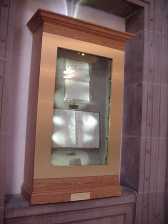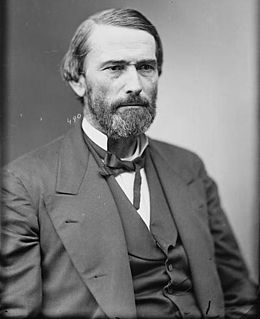
The Governor of Michigan is the head of state, head of government, and chief executive of the U.S. state of Michigan. The current governor is Gretchen Whitmer, a member of the Democratic Party, who was inaugurated on January 1, 2019, as the state's 49th governor. The governor is elected to a 4-year term and is limited to two terms.

John Moore was an American statesman and planter from Louisiana. He served in the United States House of Representatives from 1840 to 1843 and again from 1851 to 1853. He was a lifelong member of the United States Whig Party.

The 32nd United States Congress was a meeting of the legislative branch of the United States federal government, consisting of the United States Senate and the United States House of Representatives. It met in Washington, D.C. from March 4, 1851, to March 4, 1853, during the last two years of Millard Fillmore's presidency. The apportionment of seats in the House of Representatives was based on the Sixth Census of the United States in 1840. Both chambers had a Democratic majority.

The 31st United States Congress was a meeting of the legislative branch of the United States federal government, consisting of the United States Senate and the United States House of Representatives. It met in Washington, D.C. from March 4, 1849, to March 4, 1851, during the 16 months of the Zachary Taylor presidency and the first eight months of the administration of Millard Fillmore's. The apportionment of seats in this House of Representatives was based on the Sixth Census of the United States in 1840. The Senate had a Democratic majority, while there was a Democratic plurality in the House.
The 1850 and 1851 United States House of Representatives elections were held at various dates in different states from August 1850 to November 1851. The Democrats gained 17 seats, increasing their majority relative to the rival Whigs, who lost 22 seats.
Thomas Henry Bayly was a nineteenth-century politician, slave owner, lawyer and judge from Virginia, and the son of Congressman Thomas M. Bayly.

John Parsons Cook was an American lawyer and politician affiliated with the Whig Party who represented Iowa's 2nd congressional district in the United States House of Representatives from 1853 to 1855.

The Constitution of Indiana is the highest body of state law in the U.S. state of Indiana. It establishes the structure and function of the state and is based on the principles of federalism and Jacksonian democracy. Indiana's constitution is subordinate only to the U.S. Constitution and federal law. Prior to the enactment of Indiana's first state constitution and achievement of statehood in 1816, the Indiana Territory was governed by territorial law. The state's first constitution was created in 1816, after the U.S. Congress had agreed to grant statehood to the former Indiana Territory. The present-day document, which went into effect on November 1, 1851, is the state's second constitution. It supersedes Indiana's 1816 constitution and has had numerous amendments since its initial adoption.
After statehood was achieved on September 9, 1850 and until 1865, California elected its congressional representatives statewide at-large — two representatives from September 11, 1850 to 1861, and 3 representatives from 1861 to 1865.

Benjamin Wilson was an American lawyer and Democratic politician who served as a United States Representative from West Virginia) (1875–1883) and as an assistant attorney general during the administration of President Grover Cleveland.
The following table indicates the party of elected officials in Massachusetts:

The 1851 United States Senate election in New York was held on February 4 and March 18/19, 1851, by the New York State Legislature to elect a U.S. Senator to represent the State of New York in the United States Senate.
The 1850 and 1851 United States Senate elections were elections which had the Democratic Party lose seats, but retain a majority in the United States Senate.
The 1851 United States Senate election in Massachusetts was held during January 1851. Free Soil Party candidate Charles Sumner was elected by a coalition of Free-Soil and Democratic legislators over Whig incumbent Robert C. Winthrop, who had been appointed to finish the term of retiring Senator Daniel Webster.

The 1851 United States Senate election in Pennsylvania was held on January 14, 1851. Richard Brodhead was elected by the Pennsylvania General Assembly to the United States Senate.

The 1850 United States House of Representatives election in Florida was held on Monday, October 7, 1846 to elect the single United States Representative from the state of Florida, one from the state's single at-large congressional district, to represent Florida in the 32nd Congress. The election coincided with the elections of other offices, including the senatorial election and various state and local elections.
The 1850 United States elections occurred part way through Whig President Millard Fillmore's term, during the Second Party System. Fillmore had become president on July 9, 1850, upon the death of his predecessor, Zachary Taylor. Members of the 32nd United States Congress were chosen in this election. Democrats kept control of both houses of Congress.

The Fourth Wisconsin Legislature convened from January 8, 1851, to March 17, 1851 in regular session. Senators representing odd-numbered districts were newly elected for this session and were serving the first year of a two-year term. Assembly members were elected to a one-year term. Assembly members and odd-numbered senators were elected in the general election of November 5, 1850. Senators representing even-numbered districts were serving the second year of their two-year term, having been elected in the general election held on November 6, 1849.

The 1851 Connecticut gubernatorial election was held on April 7, 1851. It was a rematch of the 1850 Connecticut gubernatorial election. Incumbent governor and Democratic Party nominee Thomas H. Seymour defeated former state legislator and Whig nominee Lafayette S. Foster with 48.94% of the vote.